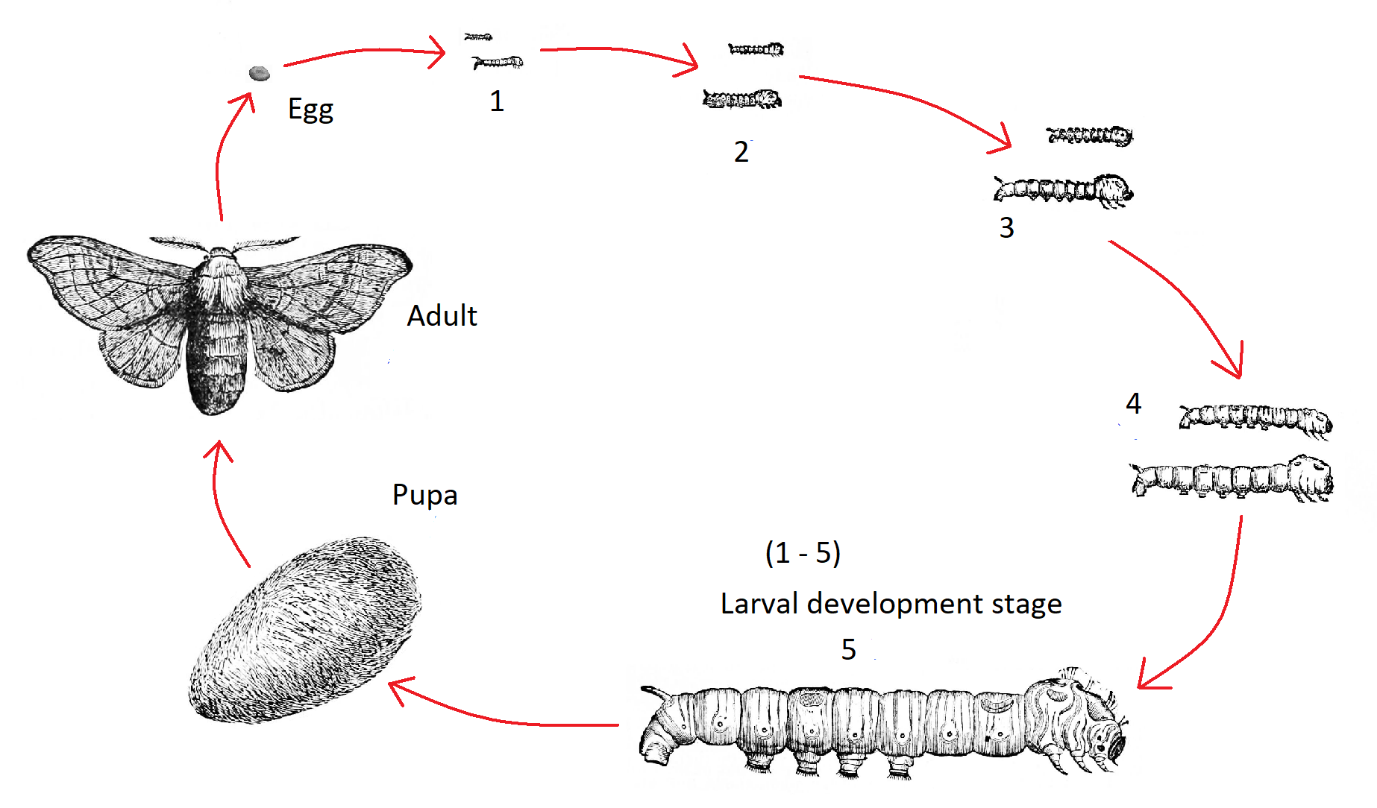
Explain the life cycle of silk moths.
Answer
406.8k+ views
Hint The domestic silk moth, Bombyx mori, belongs to the Bombycidae family of moths. Bombyx mandarina, the wild silk moth, is its closest relative. A silk moth's larva or caterpillar is known as a silkworm. It is a significant economic insect because it is the principal producer of silk.
Complete answer:
When a female silk moth lays eggs, the life cycle of the silk moth begins. The caterpillars or larvae of the silk moth are hatched from the silk moth's eggs. Silkworms produce pupa by feeding on mulberry leaves. To keep itself alive during the pupa stage, the silkworm weaves a net around itself. After that, it swings its head, spinning a protein fibre that eventually turns into silk. The cocoon is a protective layer formed by many caterpillars that surrounds the pupa. The silk thread (yarn) is made from the cocoon of the silk moth. The silkworm's life cycle is described in detail below.
Stage One: The Egg
The egg is the initial stage in the silkworm's life cycle. A female moth lays the egg, which is generally the size of a little dot. At any given time, a female moth can deposit more than 350 eggs.
Stage two: Silkworm
After the eggs hatch, a hairy silkworm emerges. The growth of silkworms occurs at this stage. They feed on mulberry leaves and eat a lot of them for around 30 days before moving on to the next stage.
Cocooning is the third stage.
Silkworms spin a protective cocoon around themselves at this stage. It's about the size of a little cotton ball and is constructed with a single silk thread. The eggs hatch in the spring because the air is warmer. This surgery takes place once a year.
Pupa is the fourth stage.
The pupa stage is characterised by its lack of movement. People kill the pupa at this stage by immersing the cocoon in boiling water and unwinding the silk thread.
Stage five: Adult:
The pupa transforms into an adult moth at this stage. After mating, the female moth lays eggs, and the silkworm's life cycle begins all over again.

Note: Silk processing is the process of extracting silk from the cocoon. Exposure to sunshine separates the silk from the cocoon. The process of unwinding silk from a cocoon begins once the reeling of silk is completed. After that, the silk thread is bleached. After that, the silk fibre is spun into silk threads.
Complete answer:
When a female silk moth lays eggs, the life cycle of the silk moth begins. The caterpillars or larvae of the silk moth are hatched from the silk moth's eggs. Silkworms produce pupa by feeding on mulberry leaves. To keep itself alive during the pupa stage, the silkworm weaves a net around itself. After that, it swings its head, spinning a protein fibre that eventually turns into silk. The cocoon is a protective layer formed by many caterpillars that surrounds the pupa. The silk thread (yarn) is made from the cocoon of the silk moth. The silkworm's life cycle is described in detail below.
Stage One: The Egg
The egg is the initial stage in the silkworm's life cycle. A female moth lays the egg, which is generally the size of a little dot. At any given time, a female moth can deposit more than 350 eggs.
Stage two: Silkworm
After the eggs hatch, a hairy silkworm emerges. The growth of silkworms occurs at this stage. They feed on mulberry leaves and eat a lot of them for around 30 days before moving on to the next stage.
Cocooning is the third stage.
Silkworms spin a protective cocoon around themselves at this stage. It's about the size of a little cotton ball and is constructed with a single silk thread. The eggs hatch in the spring because the air is warmer. This surgery takes place once a year.
Pupa is the fourth stage.
The pupa stage is characterised by its lack of movement. People kill the pupa at this stage by immersing the cocoon in boiling water and unwinding the silk thread.
Stage five: Adult:
The pupa transforms into an adult moth at this stage. After mating, the female moth lays eggs, and the silkworm's life cycle begins all over again.

Note: Silk processing is the process of extracting silk from the cocoon. Exposure to sunshine separates the silk from the cocoon. The process of unwinding silk from a cocoon begins once the reeling of silk is completed. After that, the silk thread is bleached. After that, the silk fibre is spun into silk threads.
Recently Updated Pages
The correct geometry and hybridization for XeF4 are class 11 chemistry CBSE

Water softening by Clarks process uses ACalcium bicarbonate class 11 chemistry CBSE

With reference to graphite and diamond which of the class 11 chemistry CBSE

A certain household has consumed 250 units of energy class 11 physics CBSE

The lightest metal known is A beryllium B lithium C class 11 chemistry CBSE

What is the formula mass of the iodine molecule class 11 chemistry CBSE

Trending doubts
State the laws of reflection of light

One Metric ton is equal to kg A 10000 B 1000 C 100 class 11 physics CBSE

Difference Between Prokaryotic Cells and Eukaryotic Cells

What is the modal class for the following table given class 11 maths CBSE

How do I convert ms to kmh Give an example class 11 physics CBSE

Give an example of a solid solution in which the solute class 11 chemistry CBSE




